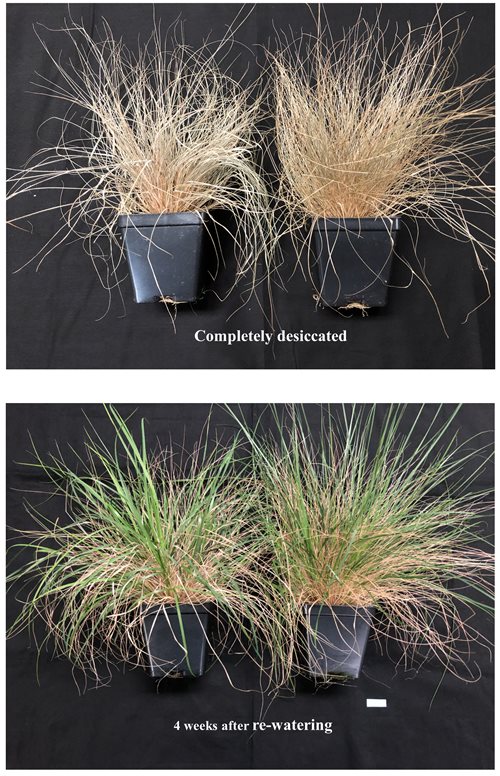Saving injera: Lessons from a teff grain's drought-tolerant cousin
Eragrostis nindensis is known as a resurrection plant: Even after a drought that would kill other grasses, and even if it has shriveled to a dead brown husk, it can rebound and sprout new green shoots when water becomes available.

“It was completely desiccated. Dead,” Shivaiah said. “Nobody thought it would come back. But I started watering and within four weeks … it came back to life.”
Like other researchers in Peter Lundquist’s lab, Shivaiah is interested in how plastoglobules, lipid droplets found in the chloroplast, mediate stress responses. He found that as nindensis stems dry, their plastoglobules increase in size. Nindensis is known to destroy its chlorophyll while drying out, to prevent photo-oxidation. Using lipidomics, Shivaiah observed that crash in chlorophyll level and an increase in smaller lipids and sugars, which he thinks are breakdown products. He suspects that some lipids are converted into sucrose, to stabilize proteins as drier conditions introduce osmotic stress. The adaptation also seems to involve reductions in the level of many plastoglobule proteins.
The findings are preliminary, Shivaiah said. After replicating them to solidify his conclusions about how the plastoglobule changes, he hopes to investigate what differentiates teff plastoglobules from those of E. nindensis.
“Teff is dessication-sensitive. It can tolerate water scarcity for a while, but not as long as E. nindensis,” he said. “Can we do genetic modification to the teff plant to make it as desiccation-tolerant as the nindensis plant?”
You can see Shivaiah's poster presentation here, as part of the Lipids and Membranes poster session, or join a discussion on Tuesday, April 27 at 3:15 p.m. EDT.
Enjoy reading ASBMB Today?
Become a member to receive the print edition monthly and the digital edition weekly.
Learn moreGet the latest from ASBMB Today
Enter your email address, and we’ll send you a weekly email with recent articles, interviews and more.
Latest in Science
Science highlights or most popular articles

From the journals: JLR
A “T” makes a difference in blood clotting. High cholesterol: two screens are better than one. Biomarkers for cardiovascular risk. Statin-induced changes to the HDL lipidome. Read about recent papers on these topics.

Decoding microglial language
Emory University scientists characterize extracellular vesicles that facilitate intercellular communication.

What is metabolism?
A biochemist explains how different people convert energy differently – and why that matters for your health.

What’s next in the Ozempic era?
Diabetes, weight loss and now heart health: A new family of drugs is changing the way scientists are thinking about obesity — and more uses are on the horizon.

How a gene spurs tooth development
University of Iowa researchers find a clue in a rare genetic disorder’s missing chromosome.

New class of antimicrobials discovered in soil bacteria
Scientists have mined Streptomyces for antibiotics for nearly a century, but the newly identified umbrella toxin escaped notice.

